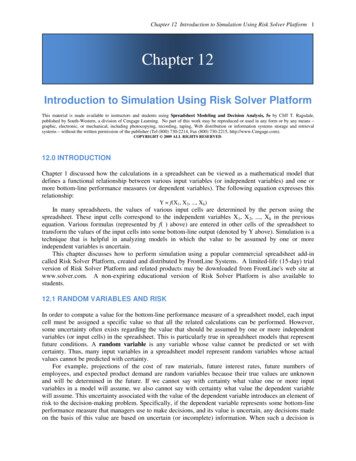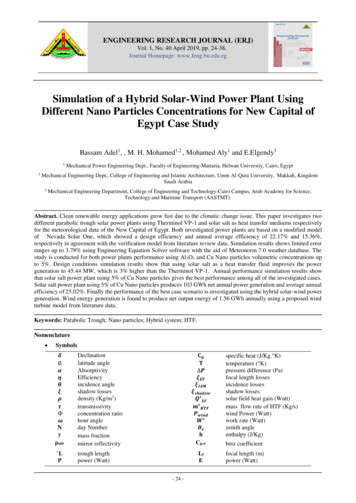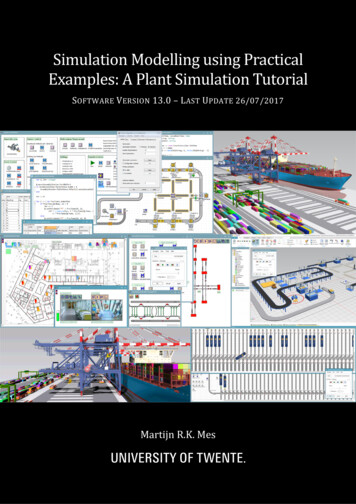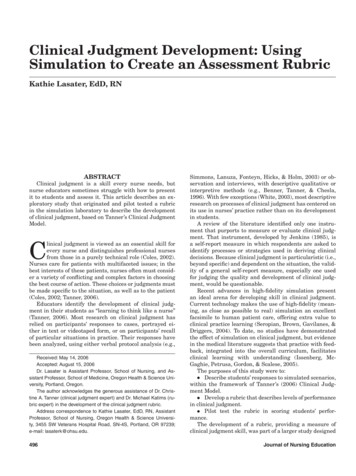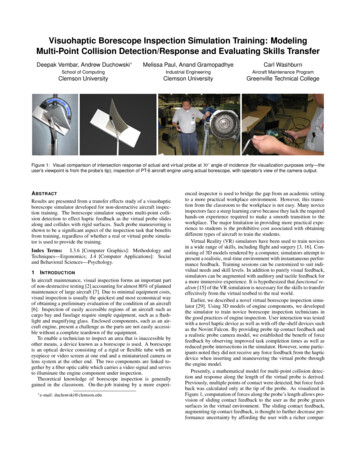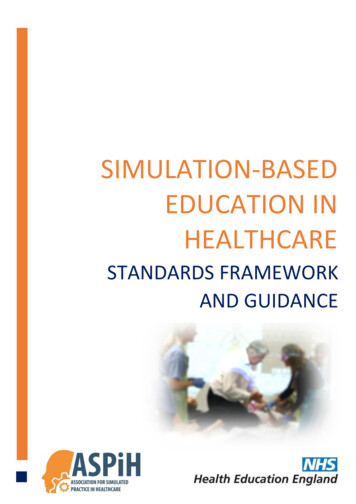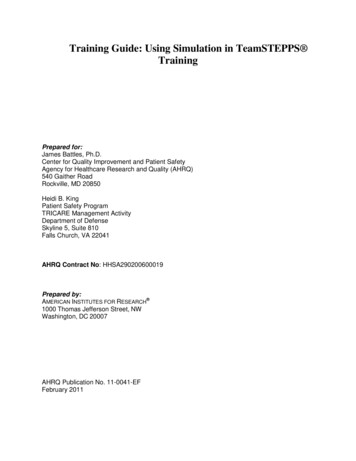
Transcription
Training Guide: Using Simulation in TeamSTEPPS TrainingPrepared for:James Battles, Ph.D.Center for Quality Improvement and Patient SafetyAgency for Healthcare Research and Quality (AHRQ)540 Gaither RoadRockville, MD 20850Heidi B. KingPatient Safety ProgramTRICARE Management ActivityDepartment of DefenseSkyline 5, Suite 810Falls Church, VA 22041AHRQ Contract No: HHSA290200600019Prepared by:AMERICAN INSTITUTES FOR RESEARCH 1000 Thomas Jefferson Street, NWWashington, DC 20007AHRQ Publication No. 11-0041-EFFebruary 2011
The views expressed in this guide are those of the authors. No official endosement by theAgency for Healthcare Research and Quality, the U.S. Department of Health and HumanServices, or the U.S. Department of Defense is intended or should be inferred. TeamSTEPPS isa trademark of the Agency for Healthcare Research and Quality and the Department ofDefense.This document is in the public domain and my be used and reprinted without permission.Citation of the source is appreciated. The suggested format is:American Institutes for Research. Training Guide: Using Simulation in TeamSTEPPS Training.Rockville, MD: Agency for Healthcare Research and Quality. AHRQ Publication No. 11-0041 EF. February 2011.ii
Table of ContentsPageIntroduction.vAudience .vPurpose.vSession Overview . viPreparation Checklist . viiTips for Facilitators of Simulation Training . viiBefore the Training Session . viiiFacilitator’s NotesI. Welcome, Introduction, Objectives, Agenda . 1II. Background . 3III. Phase 1—Scenario Development. 5IV. Phase 2—Development of Performance Measures . 10V. Phase 3—Debriefing . 14Participant HandoutsYour Expectations for This Training .H-1Objectives of Training .H-2Developing Learning Objectives .H-3Writing a Scenario for Your Learning Objectives .H-4Developing Scenarios.H-5Bibliography. B-1Acknowledgmentsiii
iv
Introduction to Using Simulation in TeamSTEPPS TrainingAudienceThe audience for this guide is health care team trainers who have been trained asTeamSTEPPS Master Trainers.PurposeThe purpose of this guide is to provide instruction on using simulation-based training whenteaching TeamSTEPPS, as opposed to using TeamSTEPPS tools and strategies insimulation training for other purposes. The use of simulation, which has been proven to be apowerful strategy in team-based health care, affords excellent opportunities to enhance thequality of continuing education for health care professionals, as well as provide educationand practice for students learning to become health care professionals.The culture of medicine has traditionally valued technical proficiency over interpersonalskills, and this may not always be the most efficacious approach to ensuring patient safety.This TeamSTEPPS simulation guide integrates critical teamwork, interpersonal, andcommunication skills into simulation-based training, thereby offering strategies and toolsthat can improve team performance and enhance patient safety.This training course can and should be adapted to meet the needs of specific health careteams and programs. It is intended as a train-the-trainer program in which key personnelbecome familiar with the materials and activities so that they can offer the simulation-basedTeamSTEPPS training to local health care teams. Users of this training course areencouraged to adapt and augment activities accordingly, substituting their own scenarios inthe training, when applicable.v
Session OverviewObjectivesBy the end of this session, participants will be able to1. Apply the Event-Based Approach to Training.2. Develop TeamSTEPPS training scenarios.3. Develop TeamSTEPPS performance measures.4. Conduct effective debriefs of team performance.5. Determine the appropriate setting for TeamSTEPPS simulation training.Materials ChecklistqComputer for use with flash drive or CD-ROM and LCD projector.qCopies of handouts for each participant.qFlash drive or CD-ROM containing the file of the PowerPoint presentation, “UsingSimulation in TeamSTEPPS Training.”qFacilitator’s notes.qFlipchart marking pens and masking tape for posting flipchart pages to walls.qPost-It Note pads for participant tables.vi
Preparation ChecklistqqqReserve space for the training.Duplicate handouts and assemble participant packets.Ensure you have a flash drive or CD-ROM of the PowerPoint presentation,“Using Simulation in TeamSTEPPS Training.”qqMake nametags or name tents for participants.qqqqArrange for food and beverage, as appropriate.Apply for CME/CEUs, if applicable, and prepare attendance sheet.Arrive a half hour before training is scheduled to begin.Check equipment to ensure that it is working properly.Pre-label three flipchart pages using the following headings: Expectations. Parking Lot Issues. Participant Feedback. This page should have two columns: one labeledpluses ( ) and one labeled deltas (p).Tips for Facilitators of Simulation Training Use questions to promote in-depth team participation. Avoid closed-ended questions (i.e., those requiring “yes” or “no” answers). Instead,ask open-ended questions, such as those beginning with “what,” “how,” and” why” toencourage deeper discussion. When a participant asks a question, direct the question back to the team, if possible.This encourages team discussion and interaction and encourages team members todiscover their own answers. Ensure that all team members are fully drawn into the discussion. Allow time for participants to consider and formulate their answers after receiving aquestion. Do not be intimidated by a few moments of silence. Silence following aquestion often will prompt responses from the group. Do not immediately provide answers when participants do not promptly respond toyour questions. Instead, try rewording, rephrasing, or restating the questions. Use active listening to indicate that you hear what participants are saying and toencourage continued participation.vii
Before the Training SessionThe following tasks should be completed before the session is held:qArrange for a place to hold the course session and ensure that it has sufficientspace and moveable chairs for break-out activities. Consider the roomarrangement that will best facilitate your activities. For this course, it is suggestedthat the room have round tables that each seat from five to eight people.qqqqSend out fliers or e-mails announcing the course and the dates.qqPrepare nametags or name tents for participants.qqRead the Facilitator’s Notes for the session, pages 1-17.qLoad the PowerPoint presentation “Using Simulation in TeamSTEPPS Training”on the computer from the flash drive or CD-ROM.qCheck the equipment to ensure that it is working properly. Check to ensure theslides can be seen clearly from the back of the room.qPre-label flipchart pages with the headings below that correspond with theFacilitator’s Notes:Order all equipment (computer, LCD projector, screen, and flipcharts).Arrange for refreshments and lunch, as appropriate.Duplicate all handouts for the session (H-1 through H-5) and arrange them intoparticipant packets. By providing a packet of materials to each participant, you canavoid the time-consuming task of distributing materials during the session.Prepare a sign-in sheet to verify attendance (if providing CME or CEU, this isrequired for each session). Include spaces for participant name, program name,address, phone and fax numbers, and e-mail address. This will be useful if youneed to make future contact with participants.Review the handouts (H-1 through H-5) and the PowerPoint presentation, “UsingSimulation in TeamSTEPPS Training,” (slides 1 through 48). Expectations. Parking Lot Issues. Participant Feedback. This page should have two columns: one labeled pluses( ) and one labeled deltas (p).viii
Facilitator’s NotesMaterialsActivitiesTimesUSING SIMULATION IN TEAMSTEPPS TRAINING: TEAM STRATEGIESAND TOOLS TO ENHANCE PERFORMANCE AND PATIENT SAFETYI. Welcome, Introduction, Objectives, AgendaPPT slide 1A. Welcome and IntroductionBegin with PPT slide #1 (title slide) on the screen. Welcome participants to thiscourse on Using Simulation in TeamSTEPPS Training: Team Strategies andTools to Enhance Performance and Patient Safety. Have each of the facilitatorsintroduce themselves and make a brief statement about their backgrounds andexpertise in simulation training and in the TeamSTEPPS approach. Tellparticipants that teamwork has been found to be one of the key initiatives withinpatient safety that can transform the culture of health care. TeamSTEPPS is anevidence-based program aimed at optimizing performance among teams ofhealth care professionals, enabling them to respond quickly and efficiently towhatever situations arise.40 min.(15 min.)Now ask participants to take no more than 1 minute each to introducethemselves, stating their names, positions, and prior experience, if any, withsimulation training or with the TeamSTEPPS approach. If participants are few innumber, they can introduce themselves one by one to the large group. Move theactivity along, allowing each person to speak for only 1 minute. If the group is toolarge to complete the introductions in 15 minutes, ask participants to pair up andshare background information (names, positions, and experience in simulationtraining or with TeamSTEPPS). Show that you are listening carefully to theintroductions, which are important because they ensure from the start that everyparticipant is acknowledged and included. However, there is sometimes atendency for some people to speak for more than 1 minute; thus, you will need tobe mindful of the time and not allow introductions to run longer thanapproximately 15 minutes.H-1;Flipchart pagemarked“Expectations”B. Objectives and AgendaRefer participants to Handout 1 (H-1) and ask them to picture themselves at theend of this training course: They are satisfied because they have learned newinformation that will help their teams perform more efficiently and effectively. Nowask them to think about two things they hope to gain from attending this courseand write these on H-1. Sample responses from the group. List responses on theflipchart page that you pre-labeled “Expectations.” Continue listing expectationsuntil there are no more responses. Post this flipchart page to a wall and allow itto remain there throughout the course. At the end of the course, you will revisitthis list of participant expectations.(10 min.)Note: It is not necessary that every participant respond to this question. It is likely that someparticipants will have expectations that have already been listed.1
MaterialsActivitiesTimesRefer to the flipchart list and identify those topics that will be addressed in thiscourse; those that have not been planned for but can be addressed easily duringthe course; and those, if any, that are outside the realm of this course. To theextent possible, identify resources (both Web-based and print materials) thatparticipants can access to address the issues that will not be covered in thiscourse. Also identify other upcoming training opportunities, as appropriate, thatwill cover these topics.PPT slide 2;H-2Now show participants PPT slide #2, Objectives, and refer to Handout 2 (H-2).Explain that there are two types of objectives: (1) Teamwork objectives thatrelate to the TeamSTEPPS approach that focuses on teamwork, interpersonal,and communication skills and (2) Technical/clinical objectives that relate to thespecific medical procedure(s). Trainers should add their own specific objectivesto PPT slide #2 to reflect the content of the simulation training they will conduct.They will also need to add the objectives to H-2 in participants’ handout packets.(3 min.)PPT slide 3Trainers will need to develop an agenda for the training they will conduct (seesample agenda under Tab A, Appendix A, of the TeamSTEPPS Instructor Guide)and integrate the content and activities into the phases listed on PPT slide #3,Course Outline. Explain that for any course they develop, they will need toidentify content for each of these three critical phases: Scenario development,measurement development, and debriefing. Be sure that the course outlinefocuses throughout on teamwork, interpersonal, and communication skills. It’shelpful to create an agenda as a participant handout, including approximatetimes for each phase as well as breaks (e.g., morning, afternoon, and lu
Training Guide: Using Simulation in TeamSTEPPS Training Prepared for: James Battles, Ph.D. Center for Quality Improvement and Patient Safety Agency for Healthcare Research and Quality (AHRQ) 540 Gaither Road Rockville, MD 20850 Heidi B. King Patient Safety Program TRICARE Management Activity Department of Defense Skyline 5, Suite 810

